Pearl of East: Your travel guide in Uzbekistan.
|
Main Menu
Tashkent
Samarkand
Bukhara
Khiva
Baysun
Nukus
Margilan
Ferghana
Nurata
Namangan
Kokand
Sarmysh Say
Termez
|
News / НовостиUzbekistan: Ecotourism in Uzbekistan, Khorezm.Recreation Areas along the Amudarya River07/02/2017 13:50
Along the banks of the Lower Amudarya River, in the north-west of Uzbekistan small strips of a unique type of riparian vegetation, the Tugai Gallery Forest can be found. The Tugai Forest is an important habitat for many wild animals such as Wild Boar, Bukhara Deer, Persian Gazelle, Red Fox, Jackal, Tolai, Hare and many bird species. Particularly in the hot summer months, the microclimate in the riparian forest is very pleasant. Hence, the Tugai Forest is a popular recreation area. Downstream of the Beruniy bridge,
a private entrepreneur has set up a small ecotourism project named El Tur. If you want to experience this special type of ecosystem, you can sit and rest in the shade of old poplar trees. Along the river there are two yurts and a tapchan where you can relax and have a picnic or a sundowner. If you want, you can try to catch a fish, which will be prepared for you on-site.
Ornithological Tour in Khorezm and Karakalpakstan
In the ruins of Qalajiq Fortress and the adjacent sand dunes, the Variable Wheatear, the Desert Warbler, the Desert Finch and the Egyptian Nightjar occur.
A very special place for passionate birders is the cemetery in the village Sayot, 5km east of Khiva. The trees in this quiet location offer refuge for a huge breeding colony of White-crowned Night-herons. More than 100 breeding pairs have been counted. During an excursion to neighboring Karakalpakstan, you can admire the birdlife near the ruins of pre-Christian fortresses. In the walls of the fortress Toprak Qal'a, a huge colony of Blue-cheeked Bee-eaters is nesting.
Next to the holy site Sultan Uvavs Bobo, visited by many worshipers, numerous birds of prey are attracted by the remains of sacrificial animals. Another important bird area is Lake Sudochie about 100km north-west of Kungrad. You can observe the entire lake from the escarpment, walk along its shore or hire a boat from the local fishermen. Some globally threatened species of water birds, amongst them the Dalmatian Pelican, Black-winged Pratincole, White-headed Duck, have been recorded there.
Huge flocks of Great White Pelicans, Great and Pygmy Cormorants, Greater Flamingos, and the White-tailed Eagle, can be observed. If you visit Lake Sudochie you should camp out for one night. The White-winged Spotted Woodpecker (Dendrocopos leucopterus) is quite common in the Tugai Forest along the Amudarya River but also in gardens and orchards. |
Calendar
Weather
Useful Links
Searching for Airways and Hotels
|

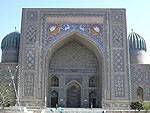
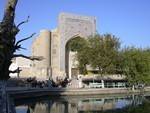
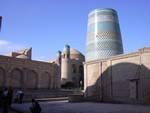
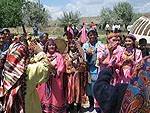
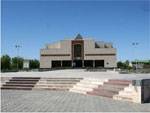
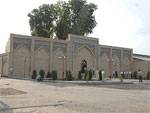
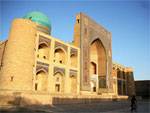
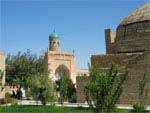
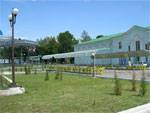


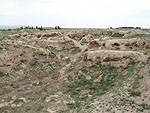

 The dominant tree species in the forest are the Euphrates Poplar, the Willow, the Russian Olive and the bright pink flowering Salt Bushes and Tamarisks.
The dominant tree species in the forest are the Euphrates Poplar, the Willow, the Russian Olive and the bright pink flowering Salt Bushes and Tamarisks.
 To reach El Tur ecotourism area, drive via Urgench towards the Beruniy bridge. Turn left just before the police check point and follow the tarred road for 1.9km until you see the sign post "EL TUR". Cross the barrier and follow the dirt road along the backwaters of the Amudarya to the banks of the main stream. A small footpath along the riverbank leads through the dense Tugai Forest to the ecotourism area.
To reach El Tur ecotourism area, drive via Urgench towards the Beruniy bridge. Turn left just before the police check point and follow the tarred road for 1.9km until you see the sign post "EL TUR". Cross the barrier and follow the dirt road along the backwaters of the Amudarya to the banks of the main stream. A small footpath along the riverbank leads through the dense Tugai Forest to the ecotourism area. In Uzbekistan, Khorezm and Southern Karakalpakstan are not only worth a visit because of their wealth of historic monuments, they also have a number of exciting binding areas. You can easily combine an ornithological outing with a cultural tour.
In Uzbekistan, Khorezm and Southern Karakalpakstan are not only worth a visit because of their wealth of historic monuments, they also have a number of exciting binding areas. You can easily combine an ornithological outing with a cultural tour. Driving from Bukhara to Khiva through the Kyzylkum Desert, you have a good chance to spot some Panda's Ground Jays near the road in the sand dunes. The preferred habitat for the birds is saxaul vegetation. When approached, they usually tiptoe away swiftly before they fly a few meters.
Driving from Bukhara to Khiva through the Kyzylkum Desert, you have a good chance to spot some Panda's Ground Jays near the road in the sand dunes. The preferred habitat for the birds is saxaul vegetation. When approached, they usually tiptoe away swiftly before they fly a few meters. The area south-east of Khiva, with its extensive water bodies consisting of lakes, fishponds, irrigation and drainage canals, has been classified by Birdlife International as "Important Bird Area" (IBA). Several globally threatened bird species and species included in the Red Book of Uzbekistan occur here. The lakes near the Khan's summer residence, Chodra Hovli, the fishponds around Ota Xarrat, the lakes near the recreation areas Qora Kol, Eshon Kol and Lake Qalajiq are other great places for bird watching
The area south-east of Khiva, with its extensive water bodies consisting of lakes, fishponds, irrigation and drainage canals, has been classified by Birdlife International as "Important Bird Area" (IBA). Several globally threatened bird species and species included in the Red Book of Uzbekistan occur here. The lakes near the Khan's summer residence, Chodra Hovli, the fishponds around Ota Xarrat, the lakes near the recreation areas Qora Kol, Eshon Kol and Lake Qalajiq are other great places for bird watching Species such as the White-tailed Lapwing, the Collared Pratincole, the Black-headed Wagtail, the Black-headed Gull (winter migrant), the Great White Pelican, the Glossy Ibis, the Blue-cheeked Bee-eater and the Eurasian Roller are commonly seen there. On the lake in front of Qalajiq Fortress, flocks of Red-necked Phalaropes can be observed. During the hot summer months (July and August), when many local people visit the lake and the adjacent dunes, it is advisable to go birding in the early morning hours before the crowds arrive.
Species such as the White-tailed Lapwing, the Collared Pratincole, the Black-headed Wagtail, the Black-headed Gull (winter migrant), the Great White Pelican, the Glossy Ibis, the Blue-cheeked Bee-eater and the Eurasian Roller are commonly seen there. On the lake in front of Qalajiq Fortress, flocks of Red-necked Phalaropes can be observed. During the hot summer months (July and August), when many local people visit the lake and the adjacent dunes, it is advisable to go birding in the early morning hours before the crowds arrive.

 The shallow shore of Lake Aksha is also an ideal habitat for many water bird species.
The shallow shore of Lake Aksha is also an ideal habitat for many water bird species.
